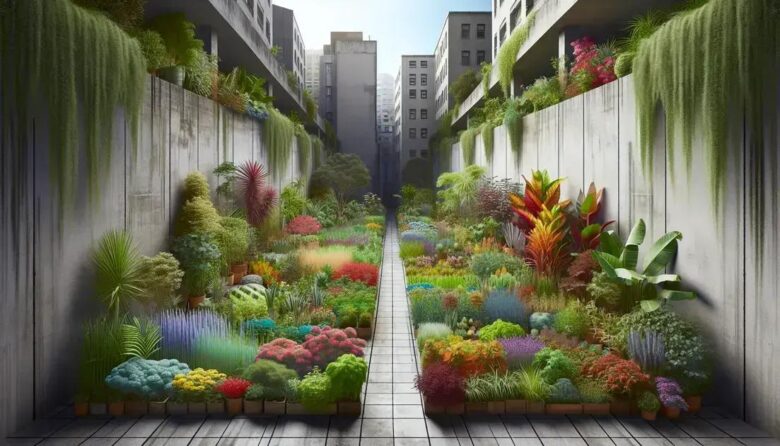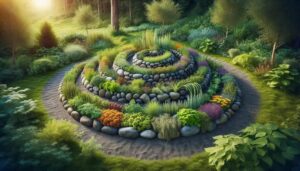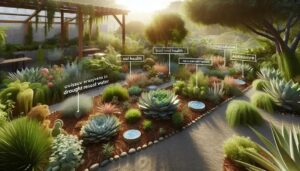Permaculture narrow garden setups can truly transform how you use limited space. Have you ever considered how a well-thought-out design could turn a cramped area into a thriving oasis? Fusing creativity with nature, these gardens embody sustainability. It’s not just about visual appeal but also nurturing ecosystems. Eager to discover how to make it work for you?
understanding permaculture principles
Permaculture is a design philosophy that emphasizes working with, rather than against, nature. It integrates land, resources, people, and the environment through mutually beneficial synergies. Understanding its principles can lead to creating more sustainable and self-sufficient landscapes.
Core Principles
The core principles of permaculture involve thoughtful observation, resource conservation, utilizing renewable resources, and minimizing waste. By focusing on these key areas, you can cultivate a garden that requires less input and provides more output.
Observation and Interaction
Observation is crucial. Spend time in your space and note sunlight patterns, wind, water flow, and existing vegetation. These insights help in designing layouts that leverage natural processes.
Resource Efficiency
Utilizing renewable resources such as sunlight and rainwater not only decreases dependency on nonrenewable sources but also enhances the garden’s efficiency. Efficient water use is vital, particularly in narrow spaces.
Creating Systems
Permaculture advocates for creating systems where each element supports the others. For instance, chickens can feed on garden waste while providing manure that enriches the soil. Establishing such relationships can make a garden more resilient.
Diversity and Resilience
Diversity in plant selection enhances resilience against pests and diseases. A varied plot is less susceptible to disorders and can maintain productivity in different conditions.
designing for narrow spaces
Designing for narrow spaces requires creativity and strategic planning. These spaces can be transformed into lush gardens by maximizing vertical height and depth. Consider using trellises and stacked planters to grow upward, allowing more plants in a smaller footprint.
Opt for plants that can thrive in tighter arrangements, such as herbs or dwarf varieties of vegetables. Raised beds can be effective in narrow gardens, improving drainage and creating defined growing areas. They also bring plants to a more accessible height for maintenance and harvesting.
Pathways are essential in narrow designs, ensuring easy access without compressing the soil. Use stepping stones or mulch-covered paths to maintain soil health. Additionally, mirror placements or water features can create the illusion of a larger space by reflecting light and adding dimensions.
Water management becomes crucial in confined areas. Install drip irrigation systems or rainwater collection barrels to efficiently manage watering needs. These elements promote sustainability while ensuring that every drop is used wisely.
Finally, integrate functional elements like seating areas or storage along the edges to make the space more livable. Multifunctional furniture can optimize space usage, serving both as a resting spot and storage for tools.
choosing the right plants
Selecting the right plants for a narrow permaculture garden involves careful consideration of space constraints and plant compatibility. Choose compact varieties or those that grow vertically to maximize limited space. Plants like pole beans, tomatoes, and peas can climb trellises, making the most of vertical areas.
Consider plants with multi-functional benefits, such as herbs and edible flowers. Herbs like basil, thyme, and oregano offer culinary uses and attract beneficial insects that aid in pest control. Edible flowers like nasturtiums add color while being both decorative and functional.
Opt for perennials whenever possible, as they return year after year and reduce the need for replanting. Strawberries and asparagus fit well in narrow gardens, providing ongoing yields with minimal upkeep.
Companion planting is essential in tight spaces. Pair plants that support each other’s growth, such as marigolds with vegetables to deter pests naturally. This technique enhances plant health and increases productivity.
Assess sunlight availability when choosing plants. Areas with full sun can support a wide range of fruits and vegetables, whereas shady spots might be better for leafy greens like lettuce and spinach.
water management in tight areas
Effective water management is crucial in narrow garden spaces, ensuring that every drop is used optimally. One technique is installing a drip irrigation system, which delivers water directly to the plant roots, reducing evaporation and waste. This setup is ideal for narrow gardens, where water conservation is key.
Rainwater harvesting can also be beneficial. Position rain barrels beneath downspouts to collect runoff from roofs. This method provides a sustainable water source that can be used during dry periods. For narrow gardens, choose compact barrels to fit snugly into available spaces.
Create contours or swales on slightly sloped areas to slow down the movement of water across the garden, allowing it to soak into the ground and nourish the plants. This technique enhances water retention, preventing runoff in limited spaces.
Adding organic mulch around plants helps to retain soil moisture, reducing the need for frequent watering. Mulch acts as a protective layer, keeping the soil cool and preventing erosion.
Selecting drought-tolerant plants for your narrow garden can also minimize water use. Native plants are often well adapted to local climate conditions and require less water, making them ideal choices for efficient water management.
integrating edible plants
Integrating edible plants into your narrow permaculture garden enhances its functionality and appeal. Start by choosing plants that offer both beauty and utility. Herbs such as basil, mint, and chives not only flavor your dishes but also attract beneficial insects like bees and butterflies.
Consider vertical gardens to maximize space. Use wall-mounted planters or hanging baskets for strawberries or cherry tomatoes, which thrive in compact areas. This technique allows you to grow more food without requiring large horizontal plots.
Edible flowers like nasturtiums and violets provide visual interest and can be used to garnish meals, making them a perfect fit for small gardens. These flowers can be interplanted with vegetables to deter pests and add a splash of color.
Planting leafy greens such as lettuce, spinach, and kale is ideal for narrow spaces. These crops have a short growing cycle and can be harvested repeatedly, providing a continuous supply of fresh greens.
Experiment with companion planting techniques, such as pairing tomatoes with basil. This not only saves space but also enhances flavors and reduces pest populations. Integrating these strategies creates a thriving, abundant garden in limited space.
maintenance tips for narrow gardens
Maintaining a narrow garden requires some clever strategies to keep it thriving. Regularly assess plant health, as compact spaces can lead to faster spreading of diseases. Remove any dead or diseased plants promptly to prevent issues from escalating.
Implement a consistent watering schedule to ensure plants receive adequate moisture without over-watering. In narrow gardens, consistent care helps promote strong root systems and prevents waterlogging.
Prune plants regularly to manage growth. This is particularly important in tight spaces where plants might compete for sunlight and air circulation. Pruning encourages healthy growth and ensures that each plant has adequate space.
Fertilize with organic compost to improve soil quality and provide essential nutrients. Narrow gardens benefit from nutrient-rich soil, supporting robust plant health and yield. Use kitchen scraps or leaves to create your own compost.
Monitor for pests and encourage beneficial insects by introducing insect-friendly plants such as marigolds or clover. These can act as natural pest deterrents and attract helpful pollinators that sustain garden health.
Creating a thriving narrow permaculture garden
The journey of designing a narrow permaculture garden involves thoughtful planning and efficient use of resources. By leveraging vertical space, choosing the right plants, and applying effective water management techniques, gardeners can transform tight areas into lush, productive landscapes.
Maintenance is key to keeping these gardens flourishing. Regular care, like pruning and introducing beneficial insects, ensures that the garden remains vibrant and healthy. By integrating edible plants, you not only beautify the space but also enjoy fresh produce right from your garden.
Ultimately, narrow gardening illustrates how even the smallest areas can yield significant rewards. Embrace the creativity and potential a narrow garden holds, turning constraints into bountiful possibilities.
FAQ – Frequently Asked Questions About Narrow Permaculture Gardens
What is the best way to start a narrow permaculture garden?
Begin by assessing your space, observing sunlight and water flow, and choosing plants that use vertical space effectively.
How can I maximize plant growth in a confined space?
Use trellises and vertical gardening techniques, and select compact or climbing plant varieties to maximize vertical space.
What are some efficient water management tips for narrow gardens?
Install drip irrigation and rainwater collection systems to ensure optimal water usage in limited spaces.
How can I incorporate edible plants in a narrow garden?
Choose herbs like basil and mint or vertical crops like cherry tomatoes and strawberries to make the most of the space.
What maintenance tasks are important for narrow gardens?
Regular pruning, consistent watering, and monitoring for pests will keep plants healthy and thriving.
How can I enhance biodiversity in a small permaculture garden?
Plant a variety of species, using companion planting techniques to encourage beneficial insect activity and improve plant health.



